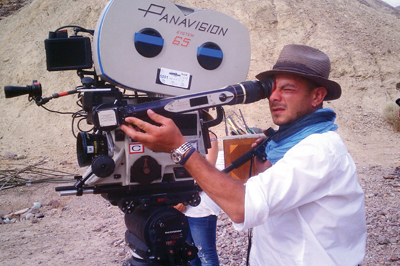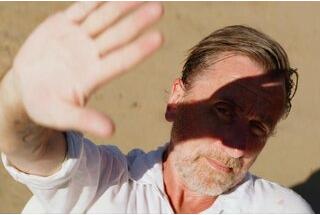Mihai Malaimare Jr. speaks about his work on Paul Thomas Anderson’s last movie "The Master"
By Madelyn MostThe film stirred up controversy as Anderson based his story on the teachings of L. Ron Hubbard, founder of the Scientology movement. Produced by Annapurna Pictures and Ghoulardi Film Company, and distributed by The Weinstein Company, the film premiered at the Venice Film Festival in September 2012 where it was awarded the Silver Lion for Best Director, and the Best Actor Prize was shared between Joaquin Phoenix and Philip Seymour Hoffman. Phoenix, Hoffman, and Amy Adams were all nominated for the 2013 Academy Awards for their outstanding performances.

Born in Bucharest, Romania in 1975, MalaimareJr. is the son of a theater actor and director, who at an early age, loved to take black and white photographs which he developed in his own darkroom. While attending the National University of Theatre and Film in Bucharest, Malaimare worked as a camera assistant and an electrician on Romanian film productions. When Francis Ford Coppola went to Romania to shoot a film, he tested 10 cinematographers in 10 days and chose Mihai for Youth Without Youth (2007). They collaborated on Tetro in 2009 and then on Twixt in 2011. When Paul Thomas Anderson’s regular DP, Robert Elswit wasn’t available for The Master, Coppola suggested Anderson speak with Mihai.
“I did three films with Francis, all with pretty small budgets, first in Romania, then in Argentina, then in Napa. We spent two years in Argentina making Tetro and we didn’t have a lot of toys, but we had so much time to make the film the way Frances wanted to. When I was on The Master, we had all the toys in the world, but there was such huge pressure on the amount of time we had to shoot. When you get everything you want, you realize what is most important is time.
“There are a lot of similarities between Paul and Francis : they write their own scripts, they direct and also produce their own films, so their involvement is total. The difference is that Francis worked with so many great cinematographers and Paul only worked with one, so it takes a while for everyone to get used to each other.”
“On The Master, Joaquim’s character was working in a portrait studio with a stills camera, so we used 1950’s photos taken with a 4x5 plate camera as references. Our original intention was to do only the portraits on 65mm, which amounted to about 20% of the movie, but as we watched film dailies every day (in a theatre projected on a screen), which were 35mm optical-reduction prints from the 65mm negative, the 65mm material looked so different from anything else we were seeing, (even reduced), and Paul liked it so much that after the first week, we began shooting on 65mm which turned out to be about 85% of the movie and the rest we shot on 35mm.”
Normally, one thinks of 65mm for panoramic shots, grand vistas and vast horizons, but in The Master, it is used to photograph faces and the short depth of field seems to further enhance the already (very) dramatic performances. The 35mm film was used for shooting the intimate scenes, for scenes on board the boat, and the long dialogue sequences as the 1000’ magazines on 65mm ran for 9 minutes only. When asked if he ever thought of shooting digital, Mihai answers that they are “still waiting for a 65mm sensor and are still struggling to store it on a hard drive”.
Malaimare tested a 2.2:1 and the 2.40:1 aspect ratio, but says it was not right for story. “The standard format of cinemas in Europe is 1.85:1, and Paul’s first film was shot in this ratio, so we decided to use that.” To keep it consistent throughout the film, Malaimare framed for 1.85:1 on both the 65mm and the 35mm cameras, they used both of Panavision’s 5-perf 65mm cameras : the Panaflex 65 Studio 65SPFX and the HR Spinning Mirror Reflex 65HSSM for shooting hand held, and a Millenium. He says the 65mm negative was cropped to a 1.85:1 format which meant cutting off the extreme left and right sides of the frame.
Malaimare explains how he tested many lenses so they could switch back and forth between the two formats and not notice a difference. They deliberately went for a very narrow depth of field. Hassleblad and Schneider lenses were Panavised to use with the 65mm cameras. They also used super speeds said to have been used by Gordon Willlis, an 80mm East German lens from 1960’s “ that was very sharp and had some nice flares” while parts of the movie were shot with a set of 35mm Zeiss Jena spherical lenses and a set of Zeiss Ultra Speeds MK IIs. Some location scenes were shot with a 19mm Kowa lens, and an Olympus 24mm lens. For close ups and for the portraiture, they used the 300mm lens which was a Hasselblad telephoto lens with Zeiss optics.
Most of the film was photographed on Kodak Vision3 50D (5203) and Kodak Vision3 200T (5213), but for some scenes and the night work, he used Kodak Vision3 250D (5207) and Kodak Vision3 500T (5219). They did extensive testing (with lenses, formats, film stocks) but Malaimare says he relies on his experience working with film emulsions and this also helps him determine the lighting package. On the 200 T stock, they were shooting wide open at 2.8, which of course presented challenges to his focus puller especially when shooting on the 300mm lens.
The lighting package included : 18K HMI Arri Maxes, 12K HMI Pars, HPL Maxi Brutes, 4K HMI’s, 2K Blondes, many 10K’s, 8 x 20K’s, 1K Pars, 9 Light Maxis, 1000 Watt Chinese Pancakes, VHO 120 Lite Ribbon LED’s, 100 Watt Dedo Lights, 500 Watt Rifas, LED Based Kino Celebs, 12X12 Light grids, Kino Flo practicals, clip lights and 200 Watt tungsten bulbs. Malaimare’s lighting package on The Master was much heavier than those on his digitally captured or low budget projects, but necessary to work with the slow film stocks negatives and not inappropriate for a $ 30million budget .
The exposed film was sent to two different labs : the 35mm footage went to Deluxe Hollywood and the 65mm went to Fotokem in Burbank who also did an optical reduction to 35mm for dailies and workprints. Although it is quite unusual these days, and costly, Mihai says they watched dailies on film every day. “We tested it thoroughly and went through the work flow, so although watching dailies on 35mm throughout the film-cost lot of money, it was very useful in the end. We knew what we wanted, the photo chemical process was giving us numbers that were very close for the final answer print, so we didn’t have to reprint. From the start, we knew we wouldn’t be doing a DI. The entire postproduction workflow was photochemical. I knew I had to be careful with the lighting”.
“Doing things photochemically delivers a better quality image and my philosophy is that if you are using these slow film stocks, and old low speed lenses with no filters on them, you don’t want to lose that quality with a scanner. With a DI, you know you have a tool in your back pocket and you can use some tricks to go darker or brighter on an actor’s face… You can move faster thinking you can fix it in the D.I. but when you don’t have a DI, you have to get everything right, especially the contrast ratio”, says Malaimare. Because Mihai had to leave for another film, the final timing of the film was supervised by the director, Paul Thomas Anderson, and the colorist at Fotokem, Dan Muscarella.
Mihai says he was influenced by the work of his father… “My father started really young, at 27 years of age, he had a pretty big TV show in Romania. He then worked as an actor and director, but wanted to do something more than classical theatre, so when he was 30, he went to Paris to study mime with Jacques Lecoq for a few years. He started his own pantomime shows and started a theatre of mime and body expression. The way he directed his theatre shows influenced me a lot. He was in a festival competing with Marcel Marceau, doing The Overcoat, by Gogol and I remember there were 180 light changes. I was 15 then and just starting to play with stills and a VHS camera and I was shooting his theatre shows. That one stuck with me because there were so many light changes, I remember the light was so beautiful. It was such a tiny space and I realized how much you could do just by changing the light”.
When asked if his films are intentionally technically complex, mixing and matching so many different elements, Malaimare answers, “ I am half engineer and I like all these technical challenges. With our craft, you can have great Ideas but you have to know how to achieve them from a technical point of view. I like to push things as much as possible. I like to try new things that weren’t tried before. On Francis’ films, we were pioneers on so many different levels”.
“When students ask me how to start a career, I still recommend being an assistant on films because that will teach you so much more than any film school. I worked as camera assistant, an electrician and a stills photographer, and I learned how each position in the crew is important and how to move certain things fast in order to leave time for other things.”
“In Hollywood, you can find everything - big budget productions and small artistic projects -, I enjoy doing both. In L.A., I just finished Nina, a film about Nina Simone which was a tiny production by U.S. standards – I think it was $ 5 million or less, and that had a completely artistic approach for everything.
This weekend I was doing the DI in New York for Plus One, directed by Dennis Iliadis, and Monday, I start A Walk among the Tombstones, with director Scott Frank, (screenwriter of Minority Report) that we are shooting on 3 formats, on HD, with RED cameras and anamorphic and spherical lenses. I am using old anamorphic lenses I discovered on the Nina Simone film and the spherical lenses I used on The Master.
“To me, all the new tools are great, the more the better. There are so many things you weren’t able to do before and what’s most important is doing something new and different, something never done before – to do a sequel or something in the same way using the same tools would be a nightmare.“
“You know the old saying : “Don’t study to be a doctor – you’ ll have to keep learning your whole life.” Well, that’s the same for cinematographers. We have to keep learning something new every day, continually, your whole life because every day there is a new toy, a new piece of equipment coming out – we just have to learn how to use it.”
(Interview conducted by Madelyn G. Most at Plus Camerimage Festival in December 2012 for the AFC)
 En
En Fr
Fr





